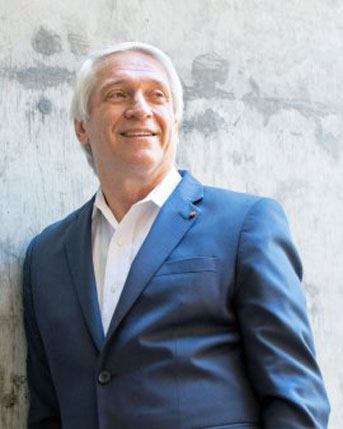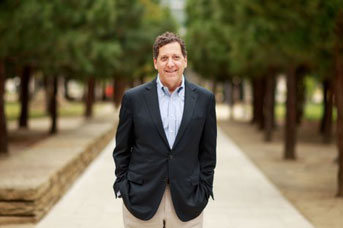Mike Billings, UC San Francisco

In the 1940s, it was cancer.
In the ’80s, it was HIV.
Today, the condition that’s battling pervasive social stigma is mental illness.
As with cancer and HIV in the past, the stigma comes at a high cost: millions of Americans go untreated because of misconceptions and shame. “Mental illness is much like cancer 75 years ago, because it’s scary and unpredictable. And because it’s still mysterious, people want to keep their distance,” says Stephen Hinshaw, Ph.D., vice chair for psychology in UCSF’s Department of Psychiatry.
Hinshaw, who has written several books about mental health stigma, is part of a growing movement in psychiatry to tackle the issues of stigma head-on and remove the barriers to treatment. He and his colleagues are focused not only on educating the public about the prevalence and treatability of mental illness, but also pushing for policy changes. One of the biggest changes is the push to approach all treatment through the lens of neuroscience – treating mental illness as a biological condition, interacting with contextual factors, instead of merely a social issue.
“Serious mental illnesses fundamentally are no different from cancer or heart disease,” says Matthew State, M.D., Ph.D., chair of the Department of Psychiatry and one of the leaders of the UCSF Weill Institute for Neurosciences. “The developing brain is particularly complex and we need a much better understanding of what’s causing those physiological disruptions and how to correct them.”
Everyone is impacted by mental illness
The effects of the stigmatization are far-reaching in the United States. The National Institute of Mental Health (NIMH) estimated that nearly one in five adults in the country – 43.8 million – was living with a mental illness in 2014. The rate among youth is just as staggering – one in five people aged 13 to 18 have experienced a serious mental disorder at some point during their life, according to NIMH.
Roopa Grewal says she felt like something was wrong with her as early as 5 years old when she would awake in the morning with horrible feelings. “I felt dirty and bad, basically like there was a black hole inside of me."
Grewal, who is Indian American, says she told her parents about her feelings, but facing stigma within the South Asian culture, there wasn’t any movement toward addressing her condition.
Only later, after she began cutting herself while a sophomore in high school, did her parents allow her to see a psychologist. Grewal says she began actively seeking mental health treatment from a psychiatrist as soon as she went to college, and it still took years to reach a proper diagnosis and receive treatment.
More than a decade passed before she was finally diagnosed by a psychiatrist, at the age of 32, as having borderline personality disorder. Today, Grewal is married, owns a home in San Francisco and is an advocate for mental health. She says she’s “living successfully” with borderline personality disorder.
What finally helped her was the right medication, combined with dialectical behavior therapy, she says. “Getting diagnosed correctly worked.”

Credit: Susan Merrell
Battling self-stigma and social distance
Others with a mental illness may not be as proactive about seeking out treatments if the stigma from society filters down to them.
“There is a high degree of what is called self-stigma,” which involves people taking on and internalizing the attributes of societal stereotypes, Hinshaw says.
Researchers have created scales to measure how much a person stigmatizes himself or herself – high levels of self-stigma predict that people either won’t go to treatment or drop out early of treatment. He says it becomes a vicious cycle: Society stigmatizes, a person picks up the message and self-stigmatizes, he or she doesn’t get engaged in treatment, and the symptoms and impairments of mental illness are never tackled.
Compounding the problem is ostracism through what is known as social distance. Here, members of society rate how close they would be willing to be in contact with a certain group, such as living in the same city, being neighbors, being friends, dating, or allowing their child to marry.
Americans are now more knowledgeable than ever about mental illness through things such as learning basic psychology in school and reading more about it in the media, but social distance has either stayed flat or gotten worse over the past half century, Hinshaw says. “People want to keep their distance from people with mental illness more than any other group in society.”

Credit: UCSF
Media focus on acts of violence – linked with mental illness – is undoubtedly a key factor. Yet on average, he notes, people with most forms of mental illness are no more likely to exhibit aggression than others, though they are far more likely to be victimized by violence.
Shortage of mental health services
The stigma people face is exacerbated by a shortage of mental health services, forcing many to live untreated or undertreated.
As millions more Americans become eligible for mental health coverage through the Affordable Care Act, the population of psychiatrists has not grown proportionally. According to a 2014 report by the Kaiser Family Foundation, only 44 percent of Californians’ mental health care needs are being met by the current availability of professionals.
“If you have a serious psychiatric problem, you are disadvantaged – you are underserved,” State told Carry the One Radio, a podcast by UCSF students.
As for many people, State’s first encounter with the mental health system was a personal experience. While in his first year of medical school at Stanford University, a close friend of his had a psychotic break.
“Despite the best efforts of a really close group of friends, she ended up on the street,” State recounted for the podcast. “She was here up at the Haight, sort of lost to her friends and family.”
The friend eventually was admitted to San Francisco General Hospital. State and a group of friends then worked over the course of a year to get her into and keep her in treatment. “It was a profoundly difficult and … disturbing experience to understand how broken the mental health system was,” he said.

Credit: Susan Merrell/UCSF
“That system feels nearly impossible to navigate, State said. “Even with private insurance and ample resources, if you have a loved one who is severely ill, there are few options but to pick up the phone and start calling anyone you know to try to find an available psychiatrist or gain access to a profoundly limited number of psychiatric beds.”
Experts believe that half of adults with a range of mental illnesses get treatment, but less than half of those people get the gold-standard treatment that they deserve, according to Hinshaw. “There is still very poor access to mental health treatments in the United States, and there is even poorer access to evidence-based treatments – the ones we know from studies really work.”
Changing minds and policies
Hinshaw says the solution to ending stigma – and therefore getting more people the treatment they need – is multipronged and needs to include policy changes, better understanding about mental illness and especially more humanization of the illnesses.
Among the laws that need to be changed are the ones in many states that deny renewal of driver’s licenses as well as disallow service on a jury or the ability to run for office to people who have been admitted for a mental illness or even a history of one, Hinshaw says. Of the existing laws, he says the federal statues that are meant to enforce parity for insurance coverage for mental health issues need better enforcement.

Credit: Susan Merrell/UCSF
On the more individual level, one fact that needs to be taught, he says, is that many people who have a mental illness – even serious ones such as schizophrenia – get better with treatment.
In a major effort to reach people who need care, UCSF’s Department of Psychiatry has embedded mental health providers in more than a dozen medical services across UCSF Health, ranging from neurology, to oncology, to pediatrics and internal medicine. It also is building a new state-of-the-art outpatient center adjacent to the Mission Bay campus that aims to break down the barriers between physical and mental health, with plans to house clinicians and scientists from psychiatry, psychology, pediatrics, neurology, and obstetrics and gynecology.
On the research side, UCSF recently established the Weill Institute for Neurosciences with the aim of integrating scientists studying the range of brain disorders. The closer alignment between the researchers is meant to promote research that seeks to understand the biological and genetic underpinnings of mental illnesses.
Hinshaw points out that the default in society is that mental health is still under a person's complete control. However, research is revealing that the causes, like with cancer, are primarily biological. The understanding of the biological and genetic causes of mental illnesses still is developing as more research is done to understand the brain.
Studies revealing genetic and biological factors
Large studies already are revealing genetic and biological factors and helping to point toward treatments. The best current research has shown that contexts switch on key genes – a combination of nature and nurture, Hinshaw says. For example, early trauma serves to intensify genetic vulnerability in many cases. Integrative models, rather than those that focus on false dichotomies, are essential.
"The scientific advances taking place now are laying the foundation for a new generation of therapies."
— Matthew State, M.D., Ph.D.
Chair, UCSF Department of Psychiatry
The research from the last decade is finally starting to unearth the genetic contributions to serious psychiatric disorders. For instance, State and colleagues at UCSF and have led groundbreaking research efforts identifying more than 60 genes involved in autism spectrum disorders. Progress in understanding schizophrenia has been just as dramatic, with recent large-scale studies pointing to more than 100 unique regions of the genome contributing to disease risk.
More such research about the brain and mental health is being funded by President Barack Obama’s Brain Initiative, including a project at UCSF that is seeking to identify the disrupted human brain circuitry involved in depression and anxiety. The project has the aim of creating devices that detect circuit aberrations and send corrective impulses to offset them.
The research at UCSF and elsewhere is going to transform the field, State says. “The scientific advances taking place now are laying the foundation for a new generation of therapies. This new understanding and the ability to do much more for patients is going to change the way that people think about mental illness – and finally eliminate the stigma that is associated with it.”

